Elsevier Encyclopedia of Geology - vol I A-E
Подождите немного. Документ загружается.


Sand boils are caused by the tendency of the excess
pore water pressures to dissipate upwards, towards
the free surface, carrying soil particles up from the
liquefied layer through cracks or channels in the over-
lying material and ejecting them at the ground surface
(Figure 3). The upward seepage of pore water, driven
by the earthquake-induced excess pore pressures, can
be impeded by less permeable overlying soil layers,
which can result in water accumulating near the inter-
face between the liquefied soil and the overlying lower
permeability soil. The accumulation of water can
loosen the soil and possibly even result in the forma-
tion of water films, either of which greatly reduces the
available shear resistance along the interface (Figure
4). This phenomenon is referred to as ‘void redistri-
bution’. A key consequence of void redistribution is
that the residual shear strength of liquefied soil does
not just depend on the pre-earthquake properties of
the soil, but also depends on those factors affecting the
dissipation and movement of pore water following
earthquake shaking.
Figure 2 Stress–strain behaviour of contractive (top) and dilative (bottom) soils under monotonic and cyclic loading. t
i
= initial
(static) shear stress. In all cases, the steady-state undrained shear strength is ultimately reached. Reproduced from Castro (1976).
Figure 3 Sand boil in liquefied soil following an earthquake;
Japan, 1983.
Figure 4 Schematic illustration of void redistribution resulting
from spreading of pore pressure and global volume changes.
Reproduced from the National Research Council (1985) Liquefac-
tion of Soils during Earthquakes. Report by the Participants in the Work-
shop on Liquefaction, Committee on Earthquake Engineering, National
Research Council, Report No. CETS-EE-001
. Washington, DC: Na-
tional Academy Press.
526 ENGINEERING GEOLOGY/Liquefaction
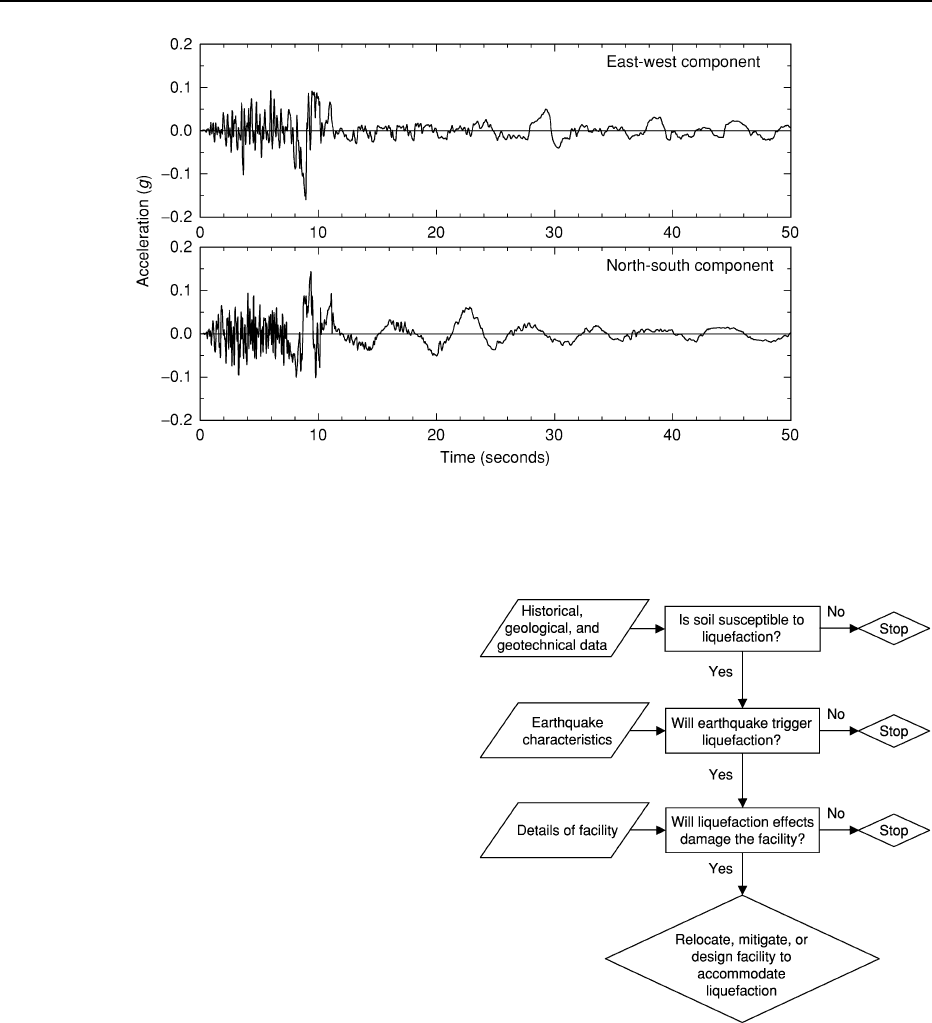
Another by-product of triggering of liquefaction is
the potential effect it has on the characteristics of the
strong ground motion. A number of accelerograms
have clearly shown the triggering of liquefaction
beneath the instrument (e.g., Figure 5).
Assessment of Liquefaction Hazard
The potential for liquefaction to cause damage is
assessed in three stages: the susceptibility to liquefac-
tion, the likelihood of liquefaction being triggered by
the design earthquake scenario, and the consequences
related to liquefaction (Figure 6). The variables that
influence the onset of liquefaction include environ-
mental factors such as the location of the water table,
site stratigraphy, and depositional and seismic
loading history of the soil; soil characteristics such
as relative density, grain size distribution, mineralogy,
and the presence of any cementing agents; and the
characteristics of the earthquake under considera-
tion, mainly the amplitude of ground shaking and
its duration.
Liquefaction Susceptibility
The most obvious evidence that a particular deposit is
susceptible to liquefaction is historical precedence,
either at the same site or in similar conditions else-
where; it is not unusual for liquefaction to re-occur in
the same location. In regions of potential hazard
where there is no historical evidence, other informa-
tion must be used to make an initial assessment of the
liquefaction risk. The criteria in Table 1, classifying
different levels of liquefaction susceptibility for vari-
ous types and ages of soil deposits, are widely used by
engineers and engineering geologists for the purposes
of either producing regional maps of liquefaction
hazard for planning purposes or for preliminary
assessment of potential hazards for site selection pur-
poses. Saturated loose cohesionless soils are the most
Figure 5 Horizontal accelerograms recorded in Niigata, Japan in the 1964 earthquake. The area surrounding the recording station
was heavily damaged by liquefaction. The onset of liquefaction appears to have occurred at approximately 10 s after strong ground
shaking commenced.
Figure 6 Flow chart for the three stages of assessing the
potential of earthquake-induced liquefaction to damage struc-
tures, lifelines, and other facilities.
ENGINEERING GEOLOGY/Liquefaction 527

vulnerable to liquefaction. Older deposits generally
have higher densities and thus greater resistance to
liquefaction.
The mode of deposition is also an important factor
in liquefaction susceptibility, as can be seen in Table 1.
Alluvial, fluvial, marine, deltaic, or wind-blown de-
posits generally have a higher susceptibility than do
either residual soils or glacial tills; materials that are
more highly consolidated. There are few case histories
of liquefaction occurring at depths greater than about
10–15 m. This is partly due to the fact that soils at
greater depths tend to be older, and therefore more
resistant to liquefaction, and also that the earthquake-
induced cyclic shear stress ratio (see eqn [1]) will be
lower at greater depths. In addition, liquefaction at
greater depths beneath level ground surfaces would
not necessarily be evident at the ground surface, and
thus may go undetected. The issue of a maximum
depth for liquefaction is of particular importance
for the construction and evaluation of large earth
dams, where the presence of significant overburden
above natural deposits should not be construed as a
reduction in liquefaction susceptibility.
When some site-specific information is available,
compositional criteria can be used to make prelimin-
ary assessments of liquefaction susceptibility. The
fines content and clay content, the Atterberg limits,
and the particle size distribution are all relevant.
Though clays are generally resistant to liquefaction,
it is also understood that plastic silts and clays may
develop significant shear strains under sufficiently
strong and sustained earthquake loading, leading to
strength loss and rapid deformation or even instabil-
ity. Compositional characteristics are used in various
criteria, such as the often-cited ‘Chinese criteria,’ to
evaluate a soil’s liquefaction susceptibility, but a clas-
sification of ‘non-liquefiable’ should not be equated
with the absence of a problem. Thus, liquefaction
evaluation procedures may not be appropriate for
plastic silts and clays, but the potential for such soils
to fail and induce damage under earthquake loading
should not be discounted.
Evaluation of Liquefaction Potential
The state-of-the-practice approach for evaluating liq-
uefaction potential at a specific site, often referred to
Table 1 Susceptibility of sedimentary deposits to liquefaction during strong seismic shaking
a
Type of deposit
Distribution of
cohesionless sediments
in deposit
Likelihood that cohesionless sediments, when saturated, would be
susceptible to liquefaction
<500 years Holocene Pleistocene Pre-Pleistocene
Continental
River channel Locally variable Very high High Low Very Low
Flood plain Locally variable High Moderate Low Very Low
Alluvial fan and plains Widespread Moderate Low Low Very low
Marine terraces and plains Widespread — Low Very low Very low
Delta and fan delta Widespread High Moderate Low Very low
Lacustrine and playa Variable High Moderate Low Very low
Colluvium Variable High Moderate Low Very low
Talus Widespread Low Low Very low Very low
Dunes Widespread High Moderate Low Very low
Loess Variable High High High Unknown
Glacial till Variable Low Low Very low Very low
Tuff Rare Low Low Very low Very low
Tephra Widespread High High ? ?
Residual soils Rare Low Low Very low Very low
Sebka Locally variable High Moderate Low Very low
Coastal zone
Delta Widespread Very high High Low Very low
Estuarine beach Locally variable High Moderate Low Very low
High wave energy Widespread Moderate Low Very low Very low
Low wave energy Widespread High Moderate Low Very low
Lagoonal Locally variable High Moderate Low Very low
Fore shore Locally variable High Moderate Low Very low
Artificial fill
Uncompacted fill Variable Very high — — —
Compacted fill Variable Low — — —
a
Reproduced with permission from Youd TL and Perkins DM (1978) Mapping liquefaction-induced ground failure potential. Journal of
the Geotechnical Engineering Division
, ASCE 104(GT4): 443–446.
528 ENGINEERING GEOLOGY/Liquefaction
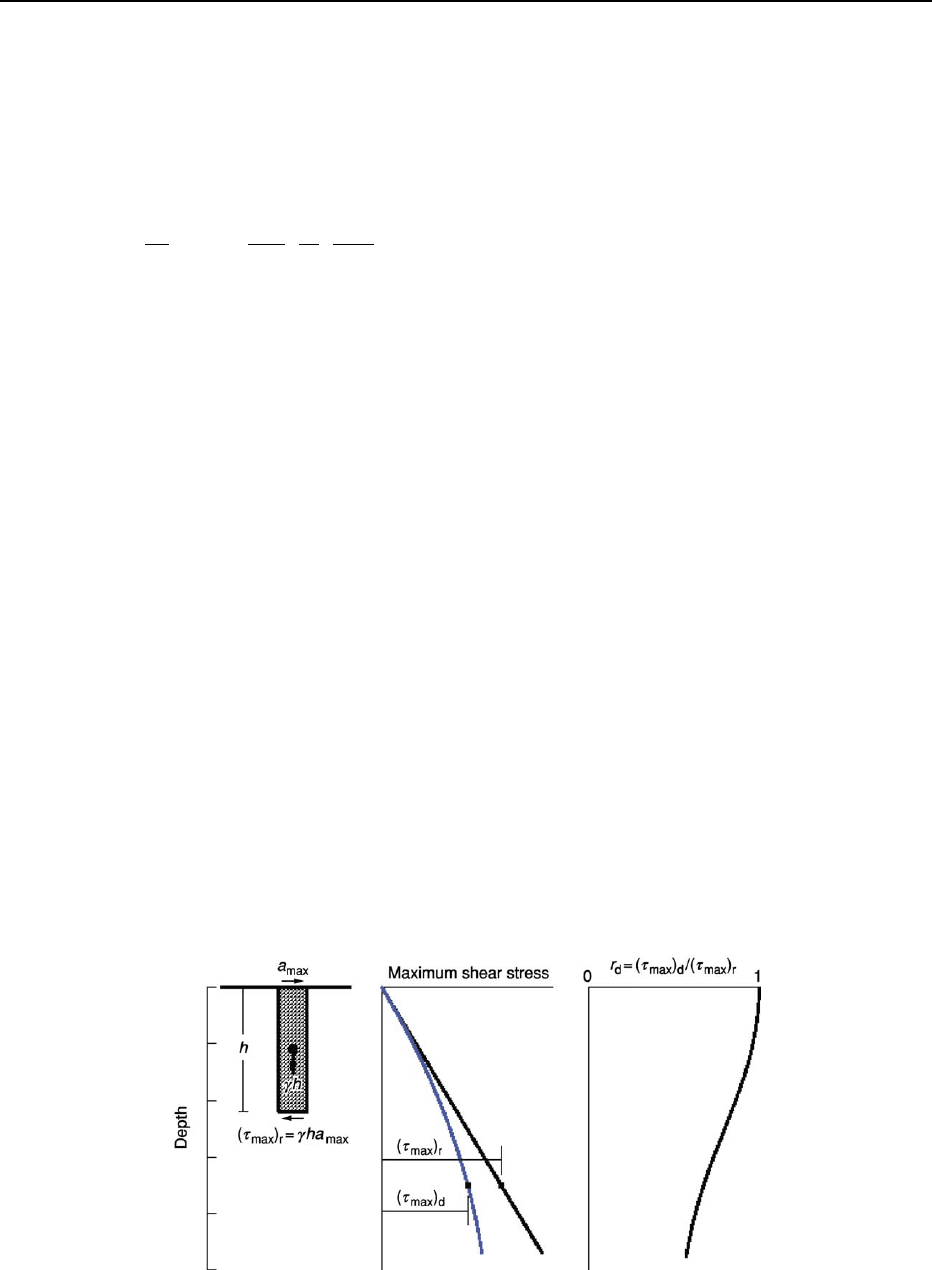
as the ‘simplified procedure’, was first published by
H B Seed and I M Idriss in 1971. This procedure
compares the shear stresses induced by an earthquake
with those required to cause liquefaction in the soil
profile, where the liquefaction resistance is based on
empirical data. The procedure is based on the
following relationship:
CSR ¼
t
av
s
0
v
¼ 0:65
a
max
g
s
v
s
0
v
r
d
MSF
½1
where CSR is the cyclic shear stress ratio, t
av
/ s
0
v
,at
the depth of the soil layer under consideration, a
max
is
the peak ground acceleration at the surface, g is ac-
celeration due to gravity, s
v
/ s
0
v
is the ratio of total to
effective vertical stress in the soil layer, and r
d
is a
stress reduction coefficient (Figure 7). MSF is a mag-
nitude scaling factor, equal to unity for M ¼ 7.5 earth-
quakes, and greater than unity for M < 7.5, to correct
in an implicit manner for the duration of shaking.
Recommended procedures for the evaluation of r
d
and MSF for use in conjunction with eqn [1] are
described in a 2004 paper by Idriss and Boulanger.
The factor of safety (F) against liquefaction is then
determined as follows:
F ¼ CRR =CSR ½2
where CRR is the cyclic resistance ratio of the soil
layer. The evaluation of CRR can be determined dir-
ectly by laboratory tests on high-quality undisturbed
samples and reconstituted samples (for new fills), or
indirectly by in situ testing. An effective method
(albeit an expensive one) of evaluating the cyclic
resistance involves collection of high-quality un-
disturbed soil samples, using techniques such as
ground freezing, and undertaking cyclic testing in
the laboratory (e.g., cyclic simple shear or triaxial
tests). The most common approach used by engineers
to determine the CRR is based on in situ testing, and
in particular the standard penetration test (SPT) and
the cone penetration test (CPT). Shear wave velocity
(V
s
) measurements and the Becker penetration test
(BPT) are also used in some specific applications.
Several publications provide guidance on the esti-
mation of CRR using in situ measurements. Such
correlations are obtained through back analysis of
case history data, and as such are related to the vari-
ables used to define the CSR (eqn [1]) for the case
histories, which can vary considerably among differ-
ent authors. For this reason, it is important that
practitioners are consistent in the methodology
they adopt, because the combination of different
recommendations could lead to incorrect results.
An example of a recently completed correlation relat-
ing CRR to (N
1
)
60
for clean sands (i.e., fines content
5%) is presented in Figure 8. The parameter (N
1
)
60
represents the SPT blowcount corrected to a ham-
mer energy level of 60% (to compensate for vari-
ations in testing equipment and procedures) and
normalized to an effective vertical stress of 1 atmos-
phere (to compensate for variations in the depth
of the in situ testing between the site and the case
history data). Similar curves for cohesionless soils
with higher fines content are also available,
based on the same data used to construct the curve
in Figure 8.
Permanent Ground Deformation
The extent of the permanent ground deformation as a
result of liquefaction will dictate the engineering solu-
tions in terms of mitigation or redesign. The interaction
between liquefied and non-liquefied soils, foundations
Figure 7 Schematic for determining maximum shear stress (t
max
) and the stress reduction coefficient (r
d
). Reproduced with
permission from Seed HB and Idriss IM (1971) Simplified procedure for evaluating soil liquefaction potential.
Journal of Soil Mechanics
and Foundations Division, ASCE
97: 1249 –1273.
ENGINEERING GEOLOGY/Liquefaction 529
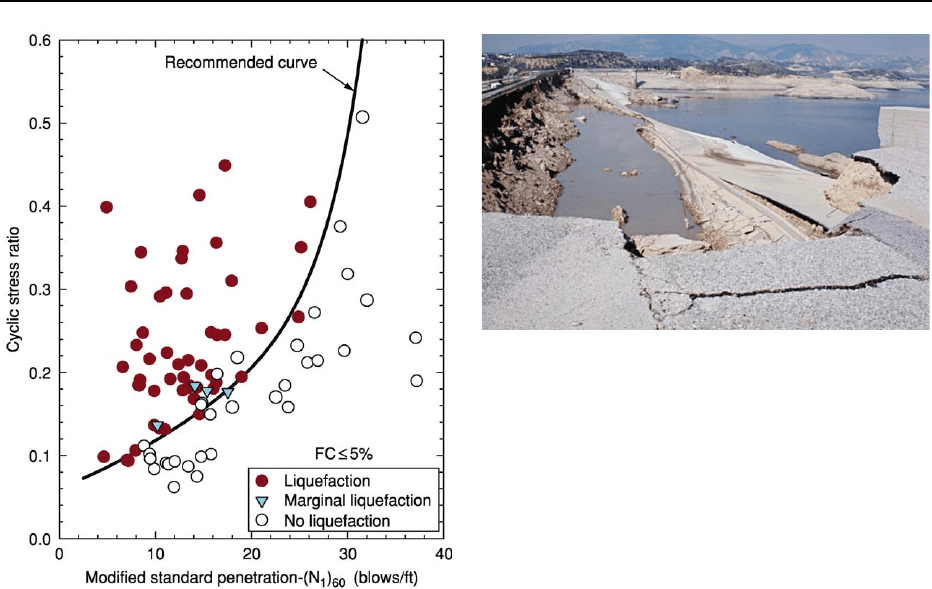
and superstructures, and soils and embedded struc-
tures (e.g., pipelines, tunnels, tanks) will determine
whether the potential for liquefaction-induced damage
is unacceptable.
Flow failure Liquefaction flow failure occurs when
the static shear stresses exceed the residual shear
strength of a liquefied soil. Normally such failures
occur on sloping ground that was stable in its static
condition but became unstable due to the reduced
shear resistance of the liquefied soil. Once movement
is mobilized, displacements can be very large (up to
tens of metres) and very rapid. The potential for flow
failure can be assessed using standard slope stability
analyses, substituting the residual undrained shear
strength (discussed later) of the liquefied layer for its
static properties, where a factor of safety below 1
indicates a flow failure hazard.
Lateral spreading Lateral spreading is also a down-
slope failure mechanism, related to cyclic mobility
(Figure 9). The disturbing forces are a combination
of the gravitational static downslope forces and the
inertial loads generated by the earthquake. Lateral
spreads can occur on gentle slopes or where there is
a free face. The factor of safety against slope failure
may remain above 1, and the ground deformation is a
result of the progressive movement of surface layers
as a result of the oscillation of the ground. Lateral
spread-induced movements of as much as 10 m have
been observed in past earthquakes.
The amount of horizontal movement can be
estimated using relationships developed from empirical
data, soil mechanics theory, or numerical modelling.
Simplified relationships developed using empirical data
are the simplest to employ, but users should consider
the uncertainty associated with any simplification of
this very complex phenomenon; simplifications neces-
sarily neglect three-dimensional effects, local effects, or
redistribution of pore water pressures, for example.
Ground oscillation Ground oscillation, another
form of lateral ground deformation, can occur
where the underlying soil has liquefied but there is
no slope or free face for permanent lateral deform-
ations to occur. Ground oscillation will manifest itself
as large-amplitude transient ground waves with little
or no resultant permanent deformation.
Settlement Liquefaction is a result of the tendency
for saturated granular soils to densify under earth-
quake shaking. The eventual manifestation of this
behaviour is settlement at the ground surface as
excess pore pressures dissipate after the earthquake.
Settlements are usually estimated using free-field,
one-dimensional relationships for the volumetric
strain induced in the soil as a function of both the
relative density of the soil and the maximum shear
Figure 8 Correlation between cyclic shear stress ratio (for an
earthquake of magnitude 7.5) causing liquefaction and standard
penetration resistance for clean sands (FC, fines content 5%).
Figure 9 The failure of the upstream slope of the Lower San
Fernando Dam shortly after the 1971 San Fernando earthquake.
California narrowly avoided catastrophic flooding of 80 000 down-
stream homes. Liquefaction of the hydraulic fill caused loss of
strength and slope instability, which left less than 1 m of free-
board after the earthquake. This picture shows the slide after
emptying the reservoir; the paved road to the left indicates the
former dam crest. Photograph by Leslie F. Harder, Jr.
530 ENGINEERING GEOLOGY/Liquefaction
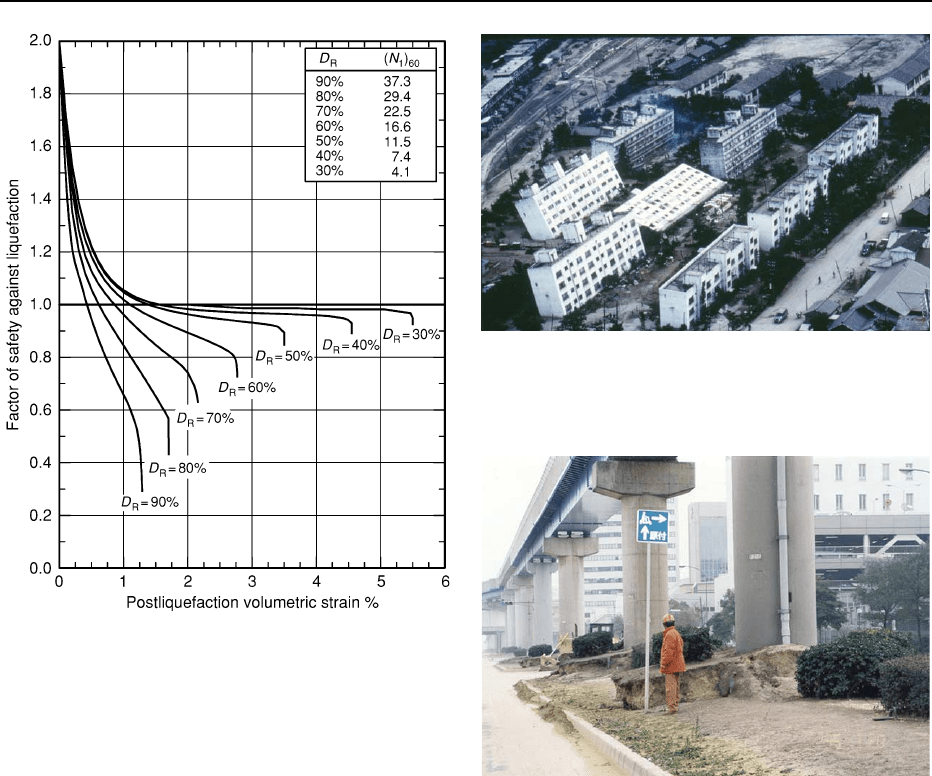
strain induced by the earthquake (Figure 10). In prac-
tice, the degree of settlement is complicated by the
heterogeneity of the soil, the interaction between ver-
tical and lateral movements, and the presence of
the structure, and most simplified methods for pre-
dicting volumetric strains have quite high associated
uncertainties.
Bearing failure If the residual shear strength of
the liquefied soil beneath is sufficiently low, then
bearing capacity failure will occur, causing the struc-
ture to settle or tilt uniformly (Figure 11). These types
of failures are generally accompanied by heaving of
the ground around the foundation. The potential
for a bearing-capacity failure can be determined
using simple static bearing-capacity formulas, substi-
tuting the residual undrained shear strength of the
liquefied layers. Failure will occur if the factor of
safety is less than unity. However, structures that are
safe against bearing failure can still develop excessive
settlements (total and differential), depending on
the strains (shear and volumetric) that develop in
the underlying soils.
Residual undrained shear strength The residual
shear strength of a liquefied soil can be determined
in the laboratory or can be estimated using correl-
ations between in situ test data and liquefied shear
strength obtained through back analysis of field case
histories. Field data, compared to laboratory tests,
tend to indicate much lower shear strengths. As well
as the difficulty in obtaining true, undisturbed
samples, some phenomena cannot be replicated in
laboratory tests. The layered nature and contrasting
permeability of in situ soil deposits can impede the
flow of water as earthquake-induced excess pore
water pressures dissipate; this can lead to localized
weakening of the soil at permeability interfaces (see
Figures 4 and 12). A further in situ phenomenon that
cannot be replicated by testing small samples is the
potential intermixing of soil layers with different
characteristics, due to the shear deformation, which
Figure 10 Chart for the estimation of volumetric strain as a
functionofthefactorofsafetyagainstliquefaction(F;eqn[2])
and the relative density of the liquefied soil layer (D
R
). (N
1
)
60
is
the standard penetration test blowcount normalized to an
equivalent overburden pressure of 1 atmosphere and hammer
energy of 60%.
Figure 11 Tilted buildings with shallow foundations in Niigata,
Japan (1964) as a result of liquefaction-induced bearing-capacity
failure.
Figure 12 An elevated transport link in Kobe following the
17 January 1995 earthquake. The bridge piers were piled, and
the structure is generally undamaged despite the settlement of
the surrounding soil by up to 1 m.
ENGINEERING GEOLOGY/Liquefaction 531
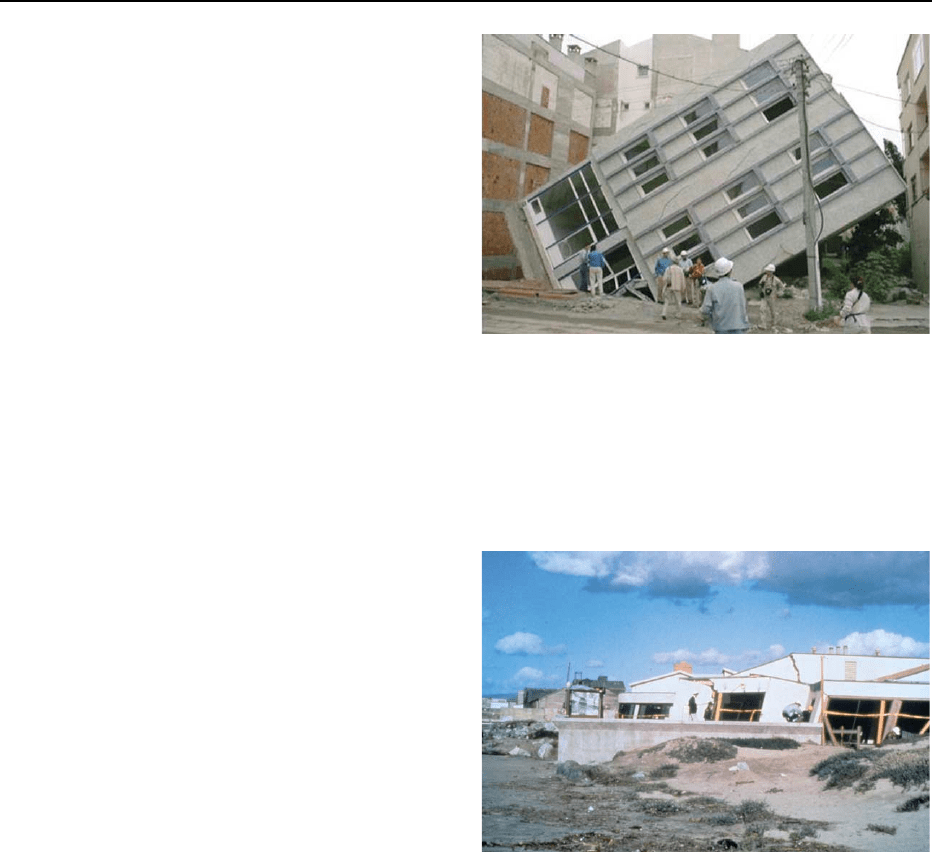
can reduce the shear strength. Field data, however,
are implicitly likely to include such phenomena. Con-
sequently, the use of the empirical correlations to
estimate postliquefaction shear strengths is recom-
mended.
Consequences of Earthquake-
Induced Liquefaction
The importance of liquefaction from an engineering
aspect is damage to the built environment, as repre-
sented by the following examples:
.
Settlements, which can be of the order of 5% of the
thickness of the liquefied soil, causing uniform or
differential settlement of foundations, pipelines, or
transportation routes.
.
Damage to piled foundations as result of loss of
support and flow of soil around piles that extend
into or through the liquefied soil layer(s).
.
Loss of bearing support to shallow or piled foun-
dations causing settlement or tilt.
.
Lateral spreads damaging building foundations,
bridge piers, highways and railways, river banks,
or embankment dams or pipelines.
.
Lateral flow failures.
.
Embankment failures due to liquefaction of under-
lying material or embankment fill.
.
Service interruption to buildings due to connection
damage caused by foundation displacements.
.
Increased lateral pressures against retaining struc-
tures such as quay walls.
.
Induced hazards, such as fire caused by gas pipeline
rupture, spread of fire due to interrupted water
supply, or floods caused by dam failure.
The severity of the damage is dependent on the
strength and duration of the earthquake ground
shaking, the thickness of the liquefied layer, the ma-
terial properties of the liquefied soil, and the proxim-
ity of free faces such as slopes or retaining structures,
as well as other variables related to the structures. The
response of a building to liquefaction-induced vertical
or lateral permanent ground deformation depends
to a large extent on the building’s foundations
(Figures 13–15). Bridge embankments are vulnerable
to lateral spreading due to the combination of suscep-
tible river channel deposits and sloping or free faces.
Bridge piers in liquefied ground can rotate, twist, or
displace laterally. In extreme cases, when liquefaction
is combined with poor design in the form of insuffi-
cient bearing width of the bridge deck, excessive
movement can cause loss of support to the bridge
deck and hence collapse (Figure 15). Damage to
roadways or railways due to liquefaction most
commonly comprises settlement or lateral spreading
of embankments, highway fills, or natural soil, which
causes cracking and uneven surfaces. Such damage is
relatively easy and inexpensive to repair but, nonethe-
less, the disruption and the indirect losses must be
considered.
The performance of a region’s lifelines networks,
including water, electricity, and gas distribution
systems, is an essential factor in the immediate emer-
gency response and the subsequent recovery from the
earthquake impact. Pipeline damage can be induced
both by transient ground oscillations and by vertical
Figure 13 Tilted apartment block in Adapazari, Turkey, due to
extensive liquefaction in the 1999 magnitude 7.4 Kocaeli earth-
quake. This building had thick, continuous, shallow foundations,
which caused it to rotate as a rigid body. There is very little
damage to load-bearing elements, walls, or ceilings; nonethe-
less, the building would have been demolished. Photograph by
Beyza Taskin.
Figure 14 Damage to the Marine Laboratory at Moss Landing,
Monterey Bay, California, during the 1989 magnitude 6.9 Loma
Prieta earthquake. Lateral spreading caused the building pad
foundations to spread apart. The laboratory was subsequently
demolished. Photograph by Leslie F. Harder, Jr.
532 ENGINEERING GEOLOGY/Liquefaction
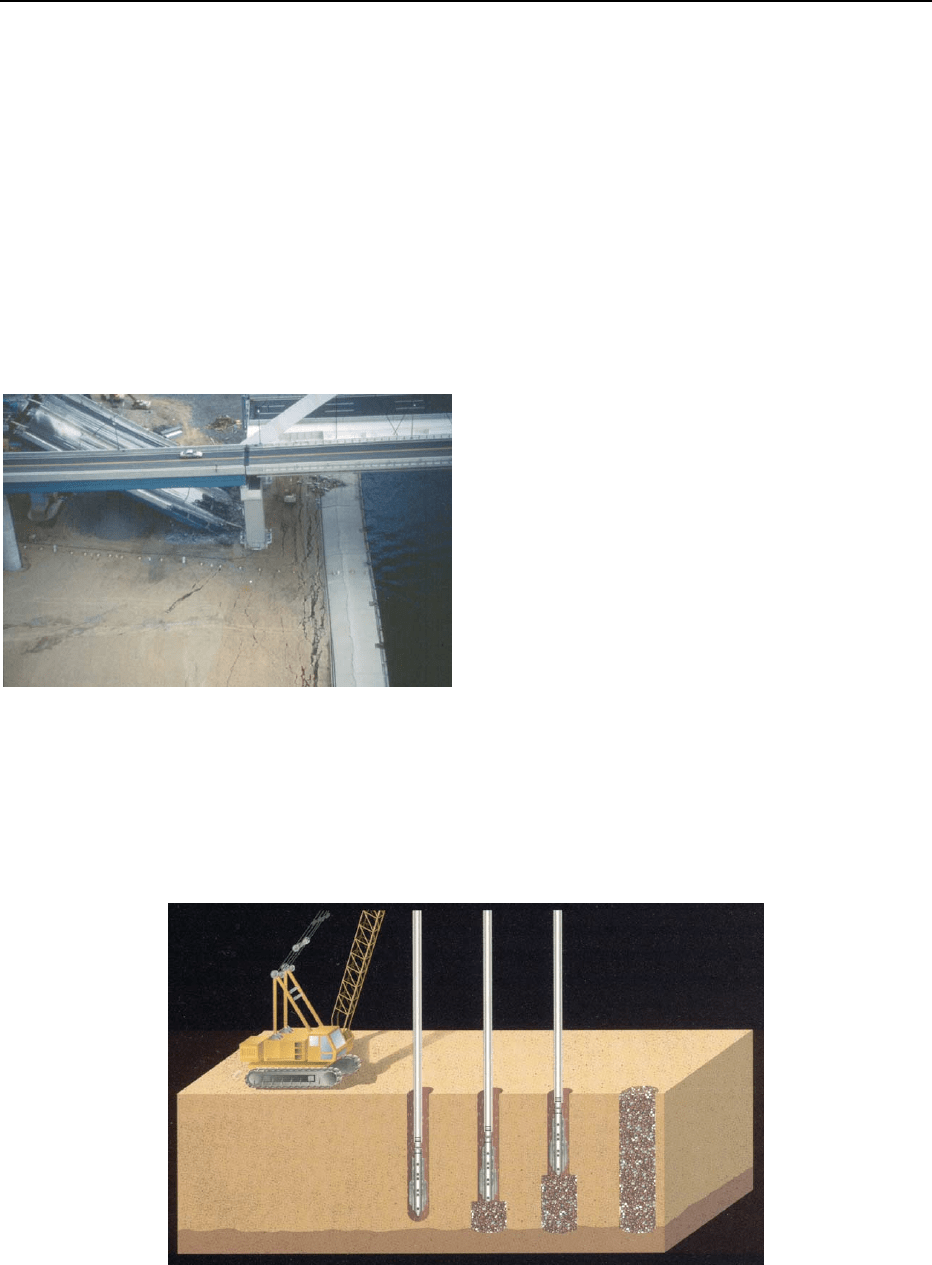
or lateral permanent ground deformations, which
can shear, compress, or pull apart pipelines at their
joints. Foundation displacements are likely to damage
pipeline connections to buildings, which can lead to
building shutdown even in the absence of structural
damage. Ruptured gas and water pipelines can trigger
fires and impede the control of fires, respectively,
creating a significant induced hazard related to lique-
faction damage to pipelines. Buried pipelines, as well
as other buried vessels such as tanks, can become
buoyant in liquefied soils. Ports and harbours tend
to be particularly vulnerable to liquefaction damage
due to the combination of high water tables,
reclaimed soils, and retained vertical faces. Dam fail-
ures due to liquefaction at the toe, or flow failure of
the embankment, can cause catastrophic damage and
massive loss of life as a result of the flooding induced
by such a failure (see Figure 9). Mitigation of lique-
faction hazard in the design of dams is therefore of
the utmost importance.
Mitigation
When the potential liquefaction risk is considered to
be unacceptable for the performance requirements of
an engineering project, the three principal options are
relocation, prevention, and effective design. Relocat-
ing a structure or facility to avoid susceptible zones
may be the most straightforward option in terms of
mitigating the effect of liquefaction. For regionally
distributed facilities such as lifeline or transportation
networks, this option is unlikely to be practicable.
The use of ground improvement to limit or prevent
the occurrence of liquefaction has been shown to be
effective in many past earthquakes. Ground improve-
ment may involve increasing the density of the lique-
fiable soil through compaction, vibration, or
replacement; reinforcing and densifying the soil
through jet grouting or deep soil mixing; or providing
additional drainage to allow excess pore water pres-
sures to dissipate more rapidly (Figure 16). Often a
combination of several techniques is adopted. Again,
this is unlikely to be an appropriate solution for
regionally distributed facilities.
Accommodation through design is the third option
to manage liquefaction risk. Foundations can be
designed to withstand expected ground deformations
Figure 16 Installation of stone columns to mitigate liquefaction through densification and strengthening of liquefiable layers
(courtesy of Hayward Baker, Inc.).
Figure 15 This span of the Nishinomaya Bridge collapsed
following the 1999 magnitude 6.9 Kobe earthquake in Japan as
a result of liquefaction-related foundation deformations. Ground
cracks behind the quay walls and parallel to the water edge are
indicative of the lateral ground movements that occurred. Sand
boils are visible on the ground surface. Photograph by Leslie
F. Harder, Jr.
ENGINEERING GEOLOGY/Liquefaction 533

and to ensure that movements are not translated to the
superstructure. Piled foundations can be designed to
accommodate additional lateral loads imparted by
soil movement, or to have sufficient vertical capacity
even in the case of negative skin friction due to settle-
ment. Shallow foundations can be designed to be suf-
ficiently strong so as to behave as a rigid body when
subjected to ground deformations. In the case of life-
line networks, the accommodation of the expected
movements, and the implementation of appropriate
response and repair measures, are frequently the only
available solution.
See Also
Engineering Geology: Aspects of Earthquakes; Seis-
mology; Site and Ground Investigation; Site Classifica-
tion. Geotechnical Engineering. Soil Mechanics.
Tectonics: Earthquakes.
Further Reading
Berrill J and Yasuda S (2002) Liquefaction and piled foun-
dations: some issues. Journal of Earthquake Engineering
6(Special Issue 1): 1–41.
Boulanger RW and Idriss IM (2004) State Normalization
of Penetration Resistance and the Effect of Overburden
on Liquefaction Resistance, pp. 484–491. 11th Inter-
national Conference on Soil Dynamics and Earthquake
Engineering and 3rd International Conference on Earth-
quake Geotechnical Engineering, University of Califor-
nia, Berkeley.
Harder LF, Jr (1997) Application of the Becker Penetration
Test for Evaluating the Liquefaction Potential of Grav-
elly Soils. Proceedings of the NCEER Workshop on
Evaluation of Liquefaction Resistance of Soils, NCEER-
97-0022.
Idriss IM and Boulanger RW (2004) Semi-empirical Pro-
cedures for Evaluating Liquefaction Potential during
Earthquakes, pp. 32–56. 11th International Conference
on Soil Dynamics and Earthquake Engineering and 3rd
International Conference on Earthquake Geotechnical
Engineering, University of California, Berkeley.
Ishihara K (1993) Liquefaction and flow failures during
earthquakes. (Rankine Lecture). Geotechnique 43:
351–415.
Ishihara K and Yoshimine M (1992) Evaluation of
settlements in sand deposits following liquefaction
during earthquakes. Soils and Foundations 32(No. 1):
173–188.
Kramer SL (1996) Geotechnical earthquake engineering.
Upper Saddle River, NJ: Prentice Hall.
National Research Council (1985) Liquefaction of Soils
during Earthquakes. Report by the Participants in the
Workshop on Liquefaction, Committee on Earthquake
Engineering, National Research Council, Report No.
CETS-EE-001. Washington, DC: National Academy
Press.
Seed HB (1987) Design problems in soil liquefaction.
Journal of Geotechnical Engineering, ASCE 113(8):
827–845.
Seed RB and Harder LF, Jr (1990) SPT-based analysis of
cyclic pore pressure generation and undrained residual
strength. In: H. Bolton Seed – Volume 2. Memorial Sym-
posium Proceedings, pp. 351–376. Vancouver, BC:
BiTech Publishers Ltd.
Seed HB and Idriss IM (1971) Simplified procedure for
evaluating soil liquefaction potential. Journal of Soil
Mechanics and Foundations Division, ASCE 97:
1249–1273.
Seed HB and Idriss IM (1982) Ground Motions and Soil
Liquefaction during Earthquakes. Monograph No. 5.
Oakland, CA: Earthquake Engineering Research Institute
(Note: A new edition of this monograph is expected
in 2005).
Tokimatsu K and Seed HB (1987) Evaluation of settlements
in sand due to earthquake shaking. Journal of Geotech-
nical Engineering, ASCE 113(8): 861–878.
Youd TL, Hansen CM, and Bartlett SF (2002) Revised
multilinear regression equations for prediction of
lateral spread displacement. Journal of Geotechnical
and Geoenvironmental Engineering, ASCE 128(12):
1007–1017.
Youd TL and Idriss IM (2001) Liquefaction resistance of
soils: Summary report from the 1996 NCEER and
1998 NCEER and NSF workshops on evaluation of li-
quefaction resistance of soils. Journal of Geotechnical
and Geoenvironmental Engineering, ASCE 127(4):
297–313.
Youd TL and Perkins DM (1978) Mapping liquefac-
tion-induced ground failure potential. Journal of the
Geotechnical Engineering Division, ASCE 104(GT4):
433–446.
534 ENGINEERING GEOLOGY/Liquefaction

Made Ground
J A Charles, Formerly Building Research
Establishment, Hertfordshire, UK
ß 2005, Published by Elsevier Ltd.
Introduction
The term ‘made ground’ is used to describe ground
that has been formed by human activity rather than
by natural geological processes. The material of which
made ground is composed is described as ‘fill’, and in
practice the terms ‘made ground’ and ‘fill’ are often
used interchangeably. Fill materials include not only
natural soils and rocks but also the waste products of
mining and industrial processes, and commercial and
domestic refuse.
Throughout history, mankind has deliberately
adjusted the topography of the Earth by excavating
soil and rock and placing the excavated material in
more convenient locations. The casual disposal of
waste materials has also changed landforms in urban
areas. These processes greatly accelerated during the
twentieth century, and in some localities, such as
major conurbations and mining areas, a significant
proportion of the surface area is now made ground.
It is therefore important that the extent, depth, and
nature of such deposits are reliably mapped and that
the geotechnical behaviour of the fill materials is
adequately understood.
A simple classification system has been developed
for describing ground affected by human activity, and
this classification is used in the geological mapping of
the UK.
.
Made ground – areas where it is known that fill
material has been placed.
.
Worked ground – areas where excavations have
been made in natural ground.
.
Disturbed ground – areas of surface and near-sur-
face disturbance (including ground that has sub-
sided), typically associated with mining.
.
Landscaped ground – areas where the ground sur-
face has been remodelled, but made ground and
worked ground cannot be distinguished.
A broad distinction can be made between ‘engin-
eered fill’ and ‘non-engineered fill’. The distinction is
essentially one of purpose: engineered fill is placed for
a specific purpose, whereas non-engineered fill is a
by-product of the disposal of waste material. Engin-
eered fill is selected, placed, and compacted to an
appropriate specification in order that it will exhibit
the required engineering behaviour; engineering
design focuses on the specification and control of
filling. Non-engineered fill is placed with no subse-
quent engineering application in view. The distinction
between engineered and non-engineered fill is clear in
principle, but not always in practice.
History
Early earthmoving activities were undertaken to meet
practical objectives, although in some cases that ob-
jective is not obvious to the modern mind. Large-scale
earthmoving has provided many durable reminders of
previous ages.
Silbury Hill, situated in Wiltshire in the south of
England, is the largest prehistoric manmade mound
in Europe and a remarkable early civil-engineering
achievement. Archaeological evidence suggests that
the 40 m high mound (Figure 1) is more than 4000
years old. It was carefully engineered in a series of six
stepped horizontal layers created from concentric
rings of chalk block walls. There are radial as well
as circumferential walls, and the compartments be-
tween them are filled with chalk rubble. The steps in
the outer slope were infilled to give a smooth slope. It
has been suggested that the hill is a burial mound, but
no graves have been found.
One practical reason for placing fill is to increase
the area of land suitable for building on within the
confines of a town or city. This has been achieved in
hill country by cut-and-fill earthworks on hillsides
and in low-lying areas by raising the level of marshy
ground. Some 3000 years ago rock-fill platform terra-
cing was formed on the eastern slopes of Jerusalem,
thereby substantially increasing the building area.
This is thought to be King Solomon’s Millo, the
Figure 1 Silbury Hill, England.
ENGINEERING GEOLOGY/Made Ground 535
